Telemedicine App Development: Challenges, Features

Telemedicine app development is a promising area today, as the healthcare system needs innovative solutions.
A telemedicine program is currently present in almost half of all U.S hospitals. Such solutions offer a lot of benefits, allowing medical facilities to streamline operations, reduce costs and doctors’ workload, and improve healthcare services.
With the latest innovations and smart technologies transforming the telemedicine industry, this segment may become a profitable investment opportunity. This article will help you get insights into telemedicine application development, covering many essential points and allowing you to explore the sphere of telehealth applications.
Here’s is what you will find in this guide:
- Market state of telemedicine platforms
- Differences between the main types of telemedicine apps
- The ways you can take advantage of telemedicine applications
- Technologies and features of a telemedicine app
- How to build a telemedicine software
- Key challenges of telemedicine app development
- The cost of creating a telemedicine app
- Revenue streams for telemedicine applications
Continue reading to learn how to turn a telemedicine app idea into a revenue-generating product.
Why Invest in Telemedicine App Development Today
If you have any doubts regarding the financial gains, statistics will dispel any of your doubts. Here are a few points that you should know about the market of telemedicine software platforms.
- In 2023, the global telemedicine market, including telemedicine software, hardware, and services, is valued at $120.4 billion
- 67% of patients have received virtual care in 2023
- Around 37% of the U.S. patients would use telehealth services
- 74% of millennials prefer telehealth visits to in-person doctor exams
- The U.S showed a 154% increase in telemedicine use and telehealth visits.
- The Telehealth Services Market in India is estimated at USD 2.63 billion in 2023
- Telemedicine can reduce the cost of doctor visits by 10-15%
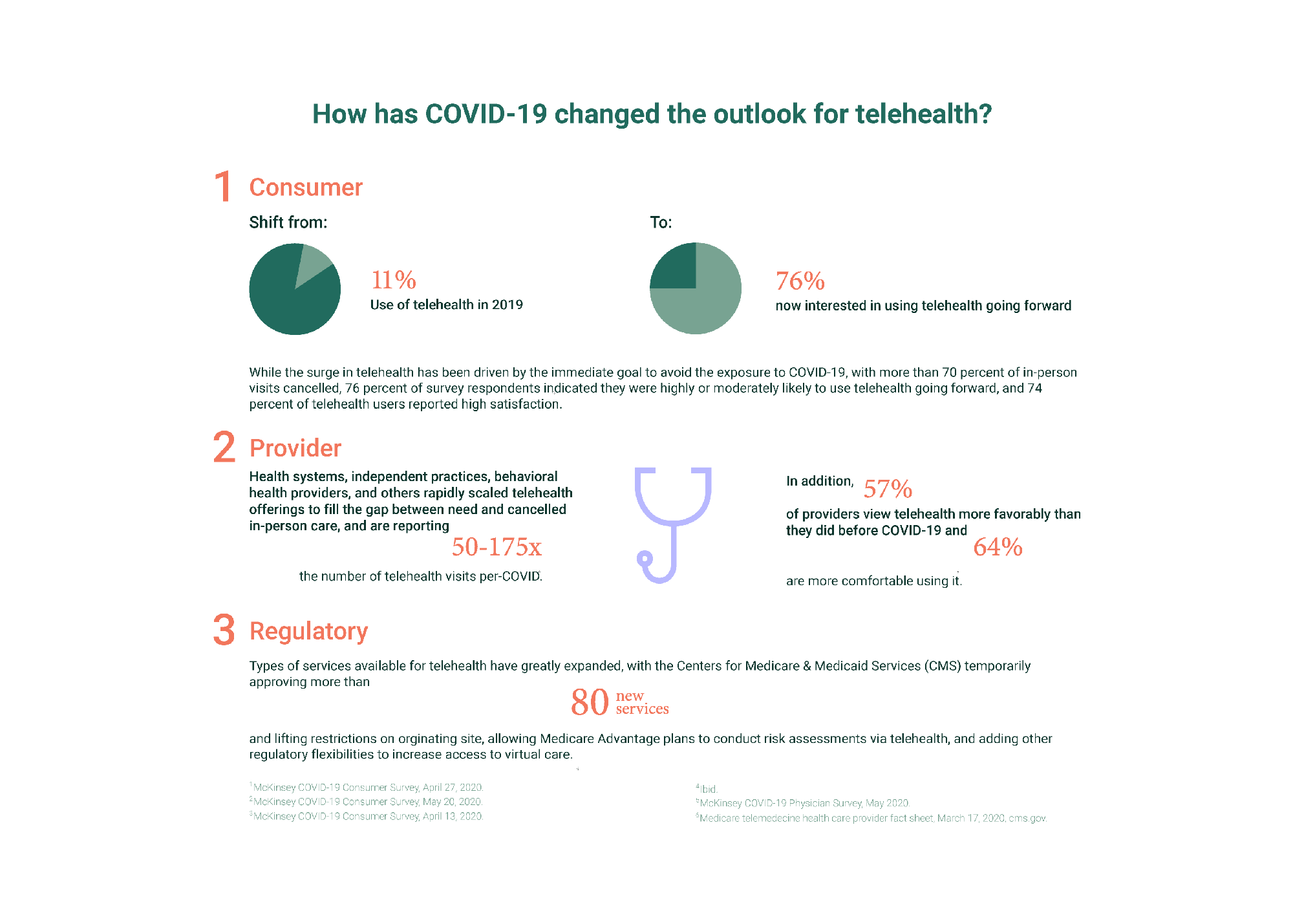
Main Types of Telemedicine Apps
What are the three different types of telemedicine?
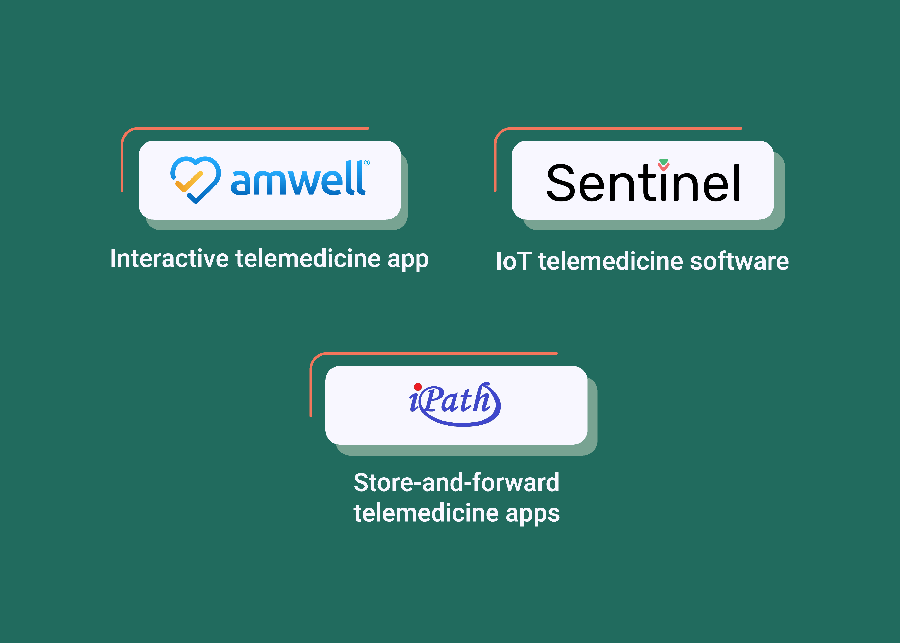
If you decide to make a telemedicine app, you will have to choose between three types of telemedicine software. The choice should fully depend on the clinic’s specialization and the services you want to provide through your telemedicine application.
- Interactive telemedicine app
This type enables phone and video calls between patients and doctors for remote doctor consultations. The main benefit of a similar app is contacting a specialist who is not available in your area. Usually, such apps are used for the following reasons:
- Follow-up consultation for newly released patients
- Neuropsychology and mental therapy
- Nursing consultations
- Pharmaceutical consultations
The app can be finished with advanced features like in-app calls and visit scheduling.
- IoT telemedicine software
The Internet of Things is a sphere of smart interconnected devices that collect and exchange information. Integrated with telehealth apps, these devices are used for remote patient monitoring. Smart devices can measure heart rate, blood pressure, level of sugar, and other clinical parameters used to monitor the state of health. Records are then automatically transferred to a telemedicine app, allowing patients and doctors to monitor changes in the patient’s state of health. Such solutions are especially beneficial for patients with chronic diseases.
- Store-and-forward telemedicine apps
The use of telemedicine solutions doesn’t always include video conferencing. Patients can record some data on a photo or video and send it to a doctor for examination. For example, patients can take photos of the results of medical examinations or even take a photo of their wounds, etc. Such telemedicine applications don’t require a patient and a doctor to be available simultaneously, increasing the efficiency of the application.
Telemedicine App Development Benefits
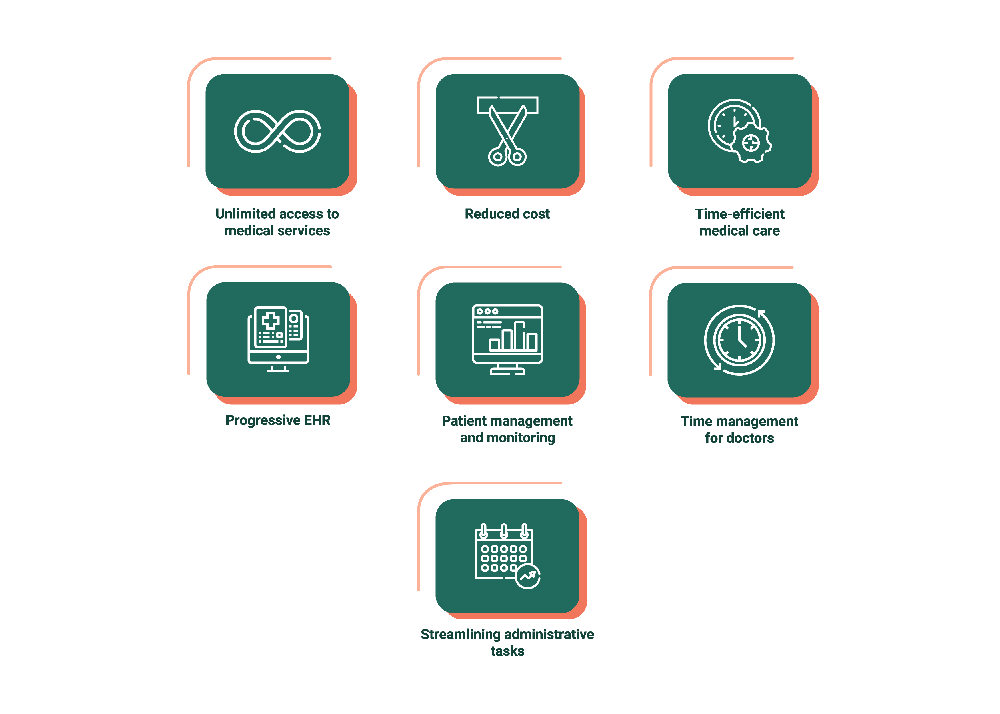
Aside from the apparent benefits of telemedicine apps, there are things you need to know before investing in app development. Let’s find out which benefits telemedicine app development can bring to patients and medical businesses.
- Unlimited access to medical services
The main benefit of telemedicine software is access to healthcare services from any location in the world. The problem is especially persistent in distant rural areas where you can witness the lack of healthcare personnel. With a telemedicine app, anyone can access doctors regardless of their physical location.
- Reduced cost
Telemedicine software brings along another essential benefit: cost saving. As patients get medical assistance remotely and without personal hospital visits, you can save money on the rent and run of working space. Thus, doctors can consult their patients from home.
- Time-efficient medical care
Often doctor’s visits may turn into countless hours of queues and waiting rooms. With busy lives, people often skip doctor’s visits, for this reason, risking their health and why not their lives. With telemedicine applications for healthcare, it is possible to get a consultation without leaving your home or during your lunch break.
- Progressive EHR
Telemedicine software can be used for electronic healthcare records management. Medical staff can access data without the need to find paper records.
- Patient management and monitoring
With telemedicine applications, it’s possible to organize efficient management of patients, control consultations, prescriptions, etc.
- Time management for doctors
With super busy schedules, doctors can be overwhelmed by the number of patients. Telemedicine app development can help address the problem by allowing the administrative staff to control the workload of doctors. Push notifications and in-app schedules won’t allow doctors to miss an appointment.
- Streamlining administrative tasks
Telemedicine solutions can be used for the efficient administration of medical establishments. Doctors can spend more time working directly with patients without filling out forms and documentation.
The list above clearly demonstrates the benefits of telemedicine app development for patients and doctors. Thus, investment if such a solution is a profitable affair for any medical institution.
Don’t hesitate to contact our team for an initial project discussion. We will provide you with recommendations, project timeline, and cost.
Technologies Used in Telemedicine App Development
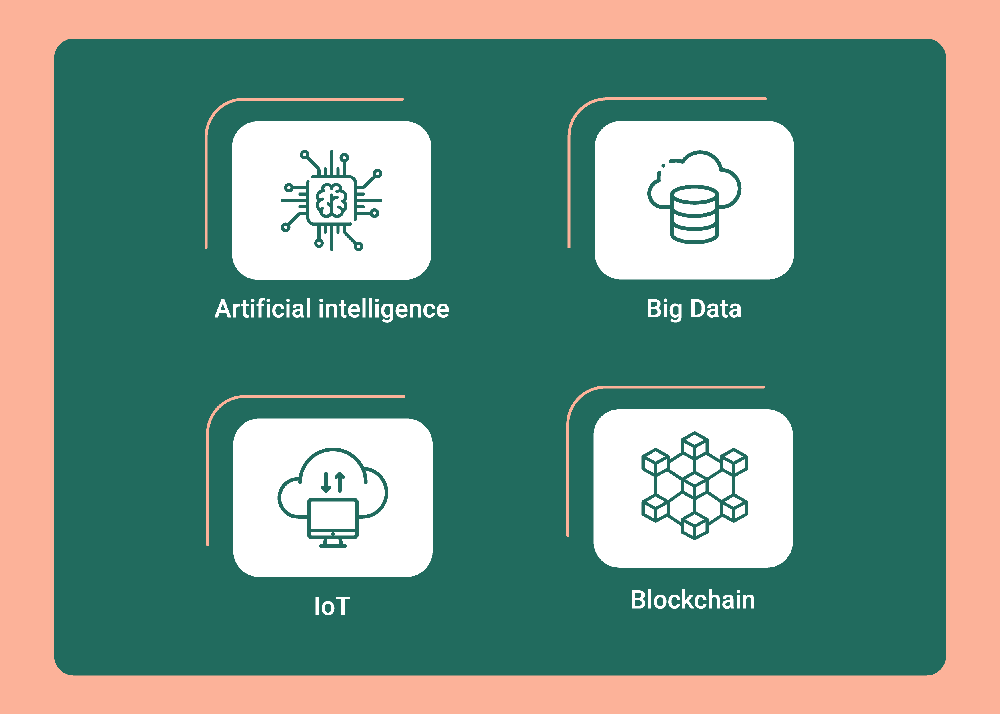
Telemedicine software development includes many technologies that are used for building great solutions. The list below demonstrates the most popular technological solutions used in telemedicine app development.
- Artificial intelligence – robust chatbots are the main use of AI in a telemedicine app. Since doctors can’t always be online, chatbots based on artificial intelligence can take on the part of essential work, like building the doctor’s schedule, answering basic questions, etc. Other possible areas of AI implementation are language processing, voice recognition, and machine learning, which combined create a supercharged experience in healthcare services.
- Big Data – the industry of telehealth apps generates a lot of data that can be further used in healthcare. The implementation of big data allows the processing of collected information to optimize services, provide better treatment and diagnostics for medical research, etc.
- IoT – the Internet of Things is another technology widely used by telehealth mobile apps. This technology unites the use of different gadgets and solutions, including but not limited to tablets, smartwatches, cameras, medical trackers, etc. These can be used to monitor vital medical conditions for a more precise diagnosis and treatment.
- Blockchain – the primary use of this technology is preventing data loss and its protection. The data is stored in distributed ledgers that prevent data tampering.
When creating a telemedicine app, you need to fully understand your product, how it will work, and which problems it will address. Don’t try to implement all of the above technologies. Choose wisely to provide a great user experience, and don’t overfill your solution with excessive technologies.
Take a look at the image below demonstrating the work behind a telemedicine app.
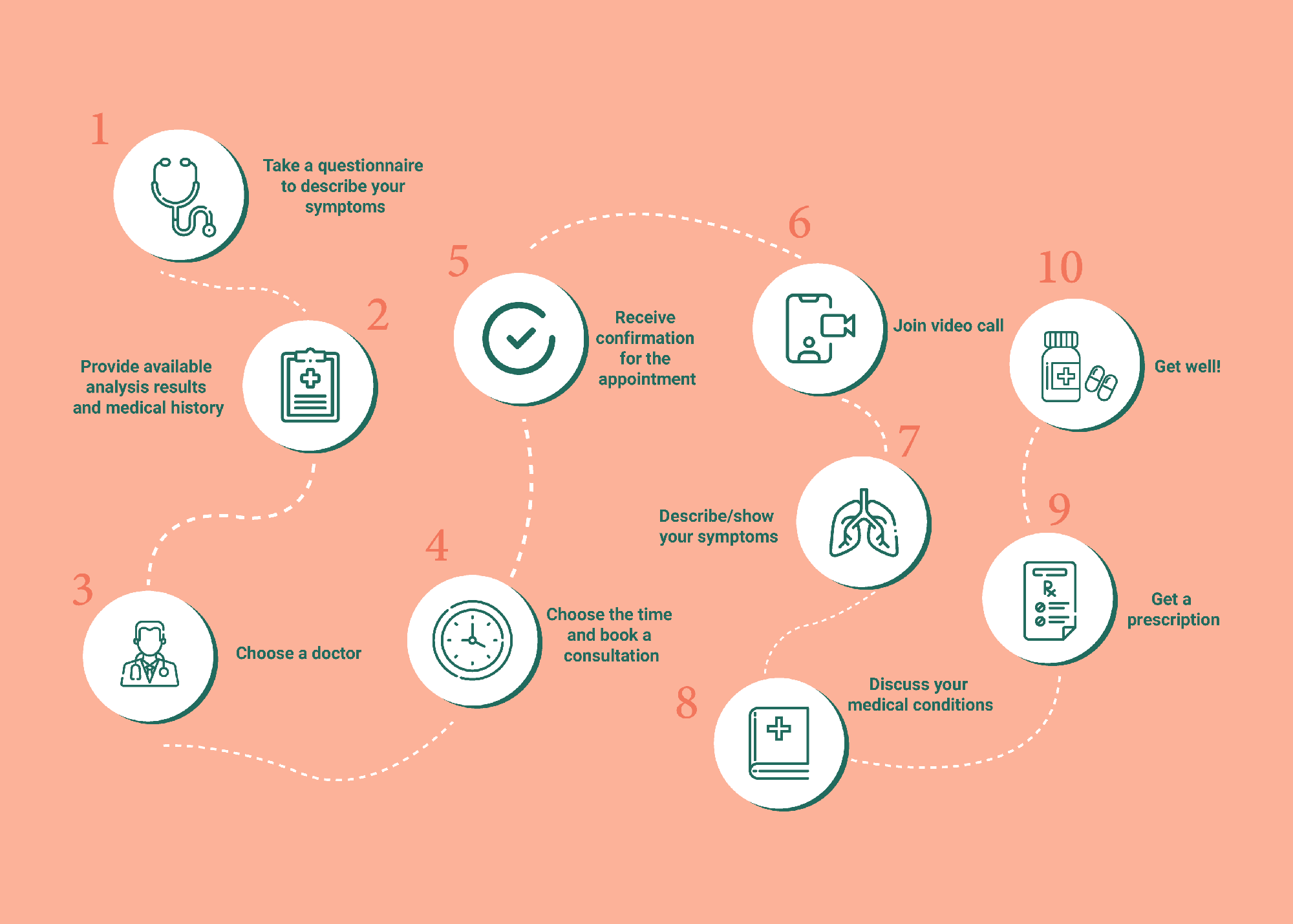
Telemedicine Platform Features for Patients
Telemedicine app development can include the following features for patients:
- Registration – patients should be able to sign up and sign in via mobile number, email, or social network. Since telemedicine solutions deal with sensitive and confidential information, it’s crucial to provide a high level of protection. One of the possible solutions is using two-factor authentication via phone, SMS, etc.
- Patient account – since patients need to provide their personal information, a user account should allow them to quickly fill out all the necessary forms. Just remember that users don’t like to spend a lot of time on such tasks; therefore, it might be a good idea to limit the number of compulsory fields.
- Search – robust search system should help patients to find specialists. You can implement the search by keywords and main criteria like specialization, location, rating, etc.
- Appointments and calendar – this feature is directly related to a similar feature for doctors. Patients need to have the ability to create appointments with doctors based on doctor availability. You need to provide them with functionality that also helps edit, postpone or cancel appointments and view the calendar with all planned doctor consultations.
- Communication tools – since telemedicine software provides remote consultations with medical specialists, patients should have the ability to communicate with them. You can add a built-in chat, video and voice calls, photo-based consultations, etc.
- Geolocation – patients should be able to connect with practitioners based on their location. This feature can be implemented with the help of Google Maps or similar technologies.
- In-app payment – integrating payment gateways like Braintree, Stripe, and PayPal will allow patients to pay for consultations inside your telehealth app. As a bonus feature, you can provide them with access to the whole history of their transactions within your application.
- Notifications – it is a must-have feature that you should definitely include in telemedicine app development. With push notifications, you can remind patients about appointments and changes in their schedules.
- Ratings & reviews – this feature ensures a high level of telemedicine services. Patients need to have the ability to rate doctors and provide their reviews. This information will help other patients to choose doctors with the best reputation.
Aside from basic features, you can provide some advanced ones:
- Medications reminders – the telemedicine app can remind patients about the need to take medications or make timely pill refills.
- Navigation – you can help patients find your hospital by providing route directions inside your application.
- Insurance plan – it is possible to integrate telemedicine software with insurance providers so that patients can use their insurance for medical consultations.
- Cloud data storage – this feature can be used to store and manage EHRs, view attached images, import and export digital files.
We’ve covered the main features you can include in a telemedicine app for patients.
Telemedicine Apps Features for Doctors
Let’s proceed to the overview of the features for doctors that can be implemented during telemedicine app development.
- Doctor profile – doctors need to specify their specialization, provide information regarding experience, and education, add their licenses, and even set up working hours.
- Scheduling and calendar – at this section of telemedicine applications, doctors should be able to set their availability, view requests for medical consultation, and have access to the schedule of all appointments.
- Communication – based on the type of app, you need to implement features for direct patient-doctor communication. Possible solutions include one-to-one messages, voice and video calls.
- EHR access – during consultations, doctors need to check patients’ healthcare records stored within an app or hospital database.
- Medical prescriptions – doctors should be able to place prescriptions within the application. This feature is great for patients with chronic diseases who need to regularly buy some medicine. Thanks to its implementation during telemedicine app development, they could get the prescribed medications without physical hospital visits.
Telemedicine software can also include some advanced features:
- Sessions recording – the recording of audio and video consultations might be very helpful for psychiatrists and other doctors. Such records can be viewed in the future to track treatment progress.
- Dashboard and analytics – there are a number of ways in which you can implement this feature.
- Pharmacy information – integration with the database of drug stores to provide doctors with information on available medications, etc.
How to Build Telemedicine Software
At Addevice, telemedicine app development is divided into 7 main steps. Each stage has its own substages with specialists responsible for each.
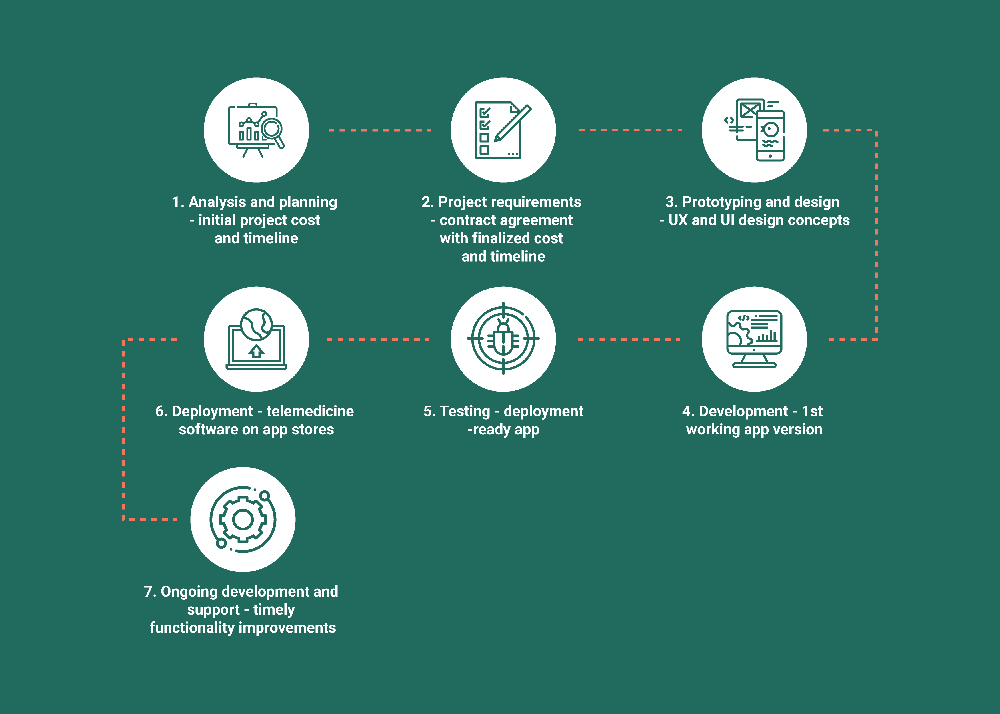
Let’s take a look at a detailed breakdown of each stage.
1. Analysis and planning
We start telemedicine app development with project analysis and planning. This stage involves close cooperation with stakeholders to identify the following points:
- Business challenges
- The best solutions for the challenges
- The best timeline and budget for the project
The main goal of this stage is to create a basic telemedicine app development project plan. Our clients get an overview of all works and resources involved in the development and decide on future work with our company.
Key deliverables: plans alignment, project timeline, cost estimation
2. Project requirements
To estimate the project scope, timeline, specialists involved, and the approximate budget, the team identifies the following points:
- The target audience
- Which problems the telemedicine software will solve
- Technical specifications and possible APIs integrations
- Security and privacy issues
The main goal of this stage is to get a full overview of the project that our team will be working on together with the client and the alignment of the assigned team with project requirements.
Key deliverables: contract agreement with details like timing, cost, and requirements.
3. Prototyping and design
At this stage, the actual work on your telemedicine project starts.
Designers draft wireframes that define in-app user flow and interactions during this stage. The main goal is to create a prototype that will provide a great user experience.
After the interface layout is finalized with our client, designers move on to creating an app’s user interface. At the end of this stage, we deliver an app design concept.
Key deliverables: UX wireframes, UI design, telemedicine app concept
4. Development
Based on the requirements, tech stack, features, and design, the team of developers handles the development process, supported by the product manager and a team of software QA engineers. The first release is an MVP product for the user acceptance test.
Key deliverables: the first working version of an app or full-fledged telemedicine platform.
5. Testing and QA
It is a mandatory stage of the development process. Quality assurance engineers thoroughly test the whole functionality of an app to ensure a high quality of code, performance, and smooth user experience.
Key deliverables: telemedicine app ready for deployment
6. Deployment
Once the telemedicine app development stage is finalized, it is time to launch a new product to the market. Our team can provide the client with the app’s source code or manage the entire process and publish your telemedicine app on relevant app stores based on project requirements.
Key deliverables: telemedicine software on app stores
7. Ongoing development and support
Once your app had been successfully launched to the market, the process of telemedicine app development continues. The main requirement for staying competitive is to provide regular updates, bug fixes, and improvements in functionality. Based on the analytics data that you collect after the app launch, together with our client, we plan for further updates and releases.
Key deliverables: app updates, guaranteed performance, and timely functionality improvements
Telemedicine App Development Project: Challenges & Considerations
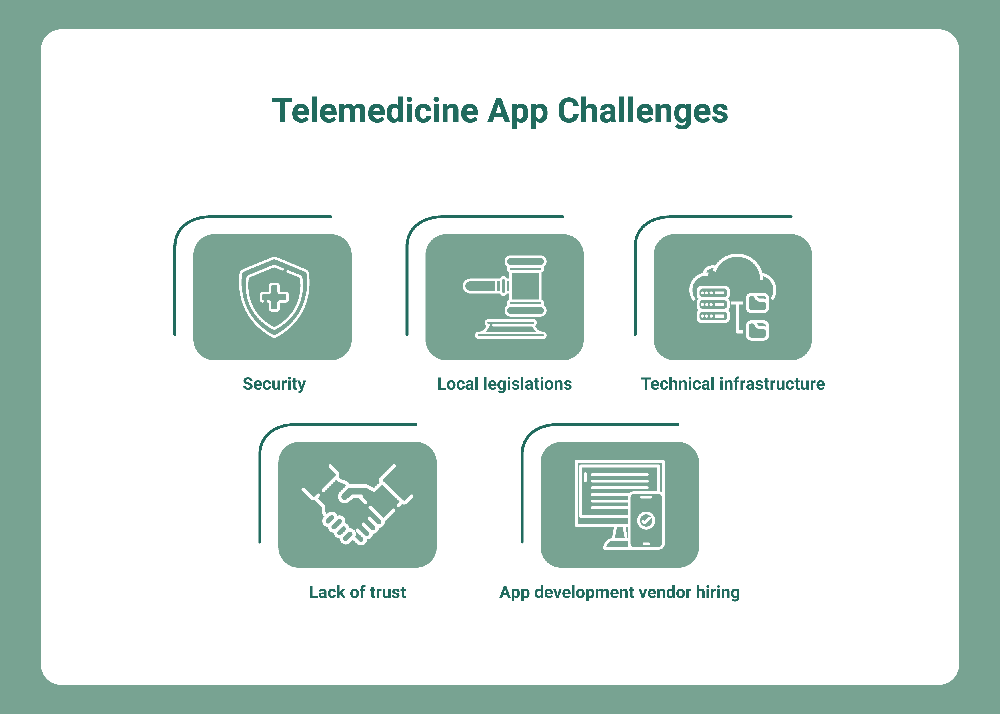
Telemedicine products are subjected to different data protection regulations and local requirements. There are a lot of challenges and pitfalls that you should be aware of before you start telemedicine app development.
Note: You can avoid any challenges with the help of an experienced healthcare mobile app development company.
Let’s investigate the main possible problems and identify the best solutions.
- Security
Telemedicine applications deal with personal and confidential information. As a result, such applications should take care of the security and protection of the stored and processed healthcare records. An important stage of telemedicine app development should be dedicated to security matters and finding ways to provide data protection.
- Local legislations
Regulatory standards make telehealth a challenging sphere. In the USA, all mobile applications dealing with patient information must be HIPAA compliant. Each country has its own regulations. In the USA, you need to abide by HIPAA, HITECH Act, CCPA, and NIST requirements. Canada has PIPEDA. The European Union has GDPR and NIS.
- Technical infrastructure
Because of the specifications of the telehealth sphere, you should be very careful with the integration of third-party services. Before integrating something into your telemedicine software, study their documentation to ensure compliance with regulations.
- Lack of trust
Lack of patient trust might become another huge challenge in telemedicine app development. To make patients trust their health to the doctors through the app, you need to guarantee their professionalism, social evidence in the forms of reviews, etc.
- Hiring a reliable telemedicine app development company
Finding a company that will help create your telemedicine app is as important as the features and tech stack. There are a few possible options that you can choose: hire an in-house development team, hire freelancers, or find an app development outsourcing company with the needed specialization.
Working with an outsourcing company is more advantageous for a business thanks to the lower development cost, access to a global talent pool, no bureaucracy of the hiring process, and much more.
You can start your research with such platforms as Clutch, the Manifest, GoodFirms, etc., that list the best software companies.
When you analyze the companies, pay attention to the following factors:
- Number of years on the market
- Availability of required talent
- Relevant experience in telemedicine app development
- Clients reviews and ratings
Telemedicine App Development Cost
So, how much does it cost to develop a telemedicine app?
Let’s answer the most important question on telemedicine app development.
Before you start looking for a development vendor, you need to understand an approximate budget required for telemedicine app development.
The cost of app development depends on the number of factors, including the region you outsource, the functionality you want to include, and the business model, etc.
Working with an offshore development company might be the most cost-effective approach to telemedicine app development.
The costs for telemedicine app development may vary from $75,000 to $250,000 and more depending on the complexity, features and platforms.
If you decide to add even more features or expand to new platforms, the cost of the telemedicine system will rise accordingly. Developing a complex telemedicine app will cost $240,000 for a single app version.
Monetization Strategies for Telemedicine Apps
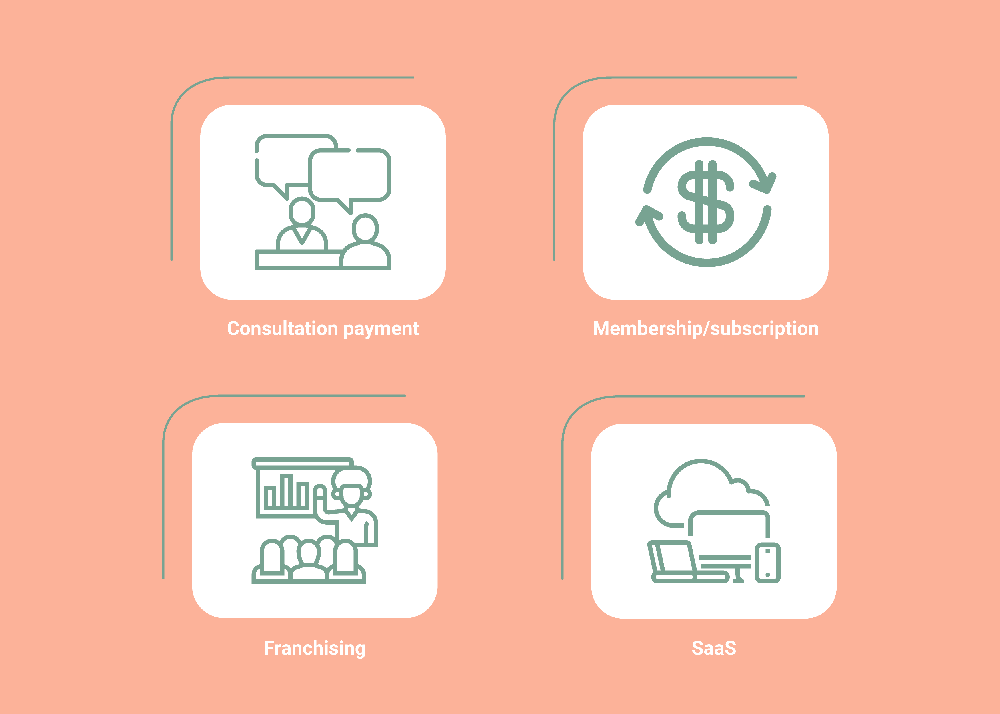
The development of any application has the main goal – getting financial gain. There are several ways to monetize the app, and the monetization strategy should proceed the development; it means you need to be sure that you will have ROI after the deployment.
Usually, you can use the following approaches to telemedicine app development monetization:
- Consultation payment – this model can be implemented in different ways with a payment for a consultation, payment based on the consultation duration, etc.
- Membership/subscription – doctors and/or patients can pay a monthly subscription fee to access the app.
- Franchising – you can offer your solution in a foreign market by selling a franchise.
- SaaS – it is possible to offer your telemedicine platform to other medical institutions for payment.
Addevice's Experience in Telemedicine App Development
Addevice is an experienced telemedicine app development company with successful and relevant experience.
Sentinel Health is an app idea that turned into a successful mobile application. Together with our client, we created a robust solution that allows patients to track their health 24/7 with FDA-approved wearables and communicate with their medical care teams.
To create a robust telemedicine app for iOS and Android, the following solution was applied:
- Artificial Intelligence – analyzes patient information and generates predictions and possible diagnoses.
- FDI approval – the app collects data from thermometers, blood pressure monitors, glucometers, etc.
- AI messaging – sends critial information and recommendations to patients automatically.
In the image below, you can see the key deliverables that the developed solution brought to business:
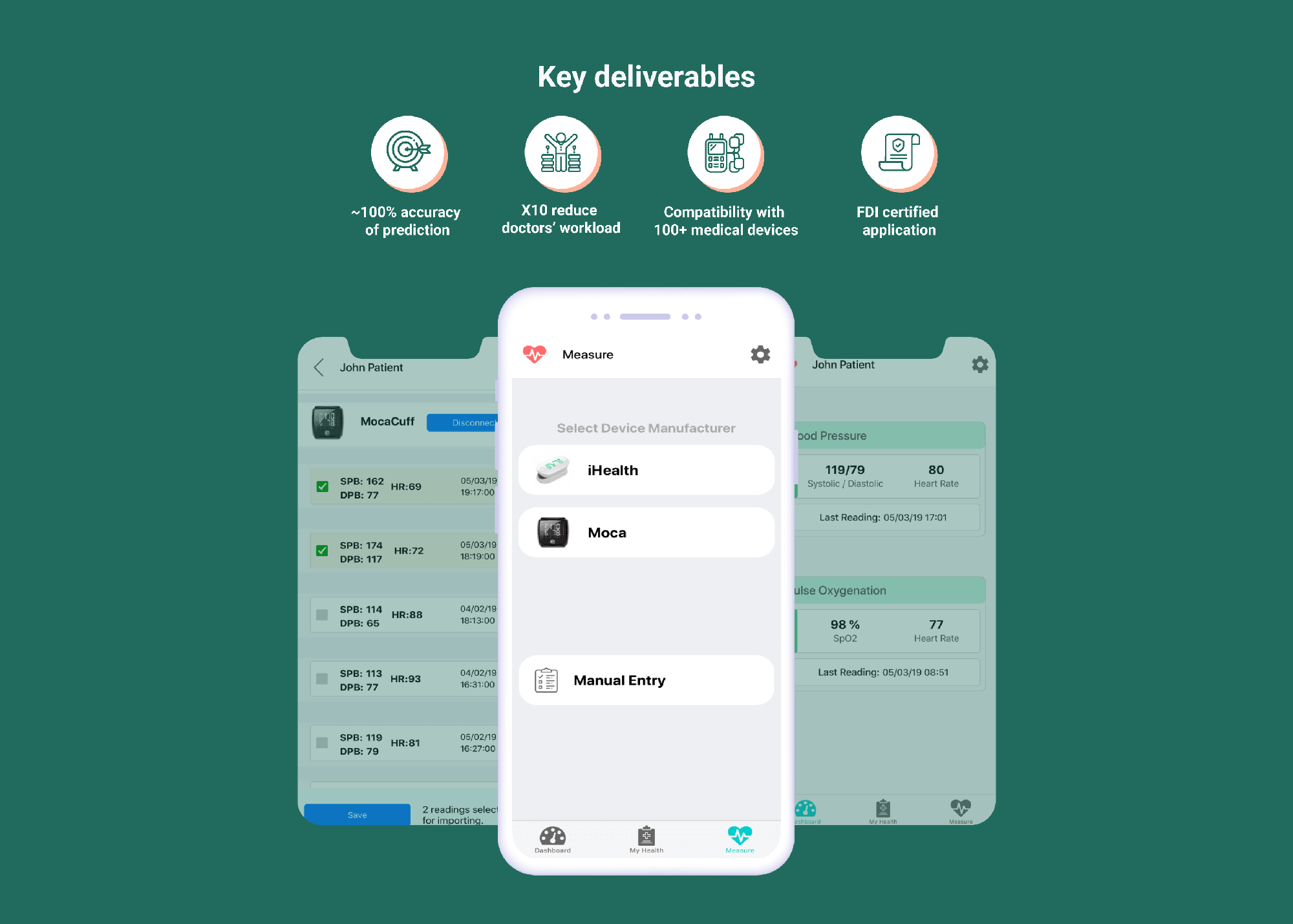
Telemedicine app development process, key takeaways
- Start with identifying your target audience – companies or patients who will be interested in your application.
- Come up with a unique selling proposition – how your telemedicine software will be different from competitors.
- Decide on the basic and advanced functionality – come up with features that will help the app meet all your business requirements.
- Find a reliable software development vendor – choose a company based on client reviews, relevant experience, availability of needed specialists, etc.
- Allocate resources – decide how much money you will need to spend on development, promotions, and app support.
- Create business objectives – decide on key metrics to track and measure the results of your work.
Telemedicine App, Medical Apps, Mobile Medicine, Healthcare and Medical Apps, Lifestyle Trackers and Their Benefits, Restaurant App development, Social Network App, Healthcare in Mobile, MVP Development, Workout Applications, Telemedicine
Develop Your Telemedicine App
Embrace the future of healthcare with your own telemedicine app
Our Expertise Covers:
✅ Video consultations and virtual appointments
✅ Electronic health records integration
✅ Secure and compliant telehealth solutions
Table of contents
FAQ
Telemedicine app connects doctors and patients who need remote doctor consultation. Such applications can include different solutions for communication, including AI messaging, voice, and video calls.
The cost of a telemedicine system depends on the number of supported platforms, tech integrations, and the complexity of features. A basic telemedicine app costs $75,000-$250,000+for a single app version (iOS or Android). Developing a telemedicine app with advanced features costs $240,000+ for a single app version.
Aside from a standard technology stack used to create mobile applications, telemedicine products are usually based on the following technologies: Artificial Intelligence, Big Data, IoT, and Blockchain.
 How Much Does It Cost to Build a Messaging App?
How Much Does It Cost to Build a Messaging App?
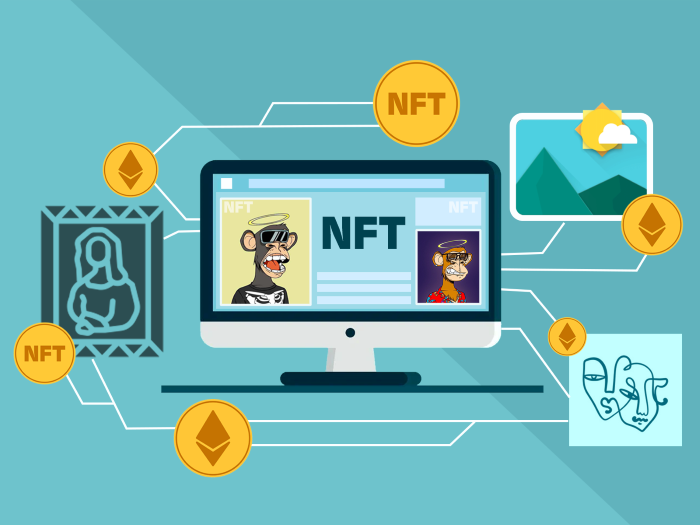 How to Create an NFT Marketplace: Development Guide
How to Create an NFT Marketplace: Development Guide
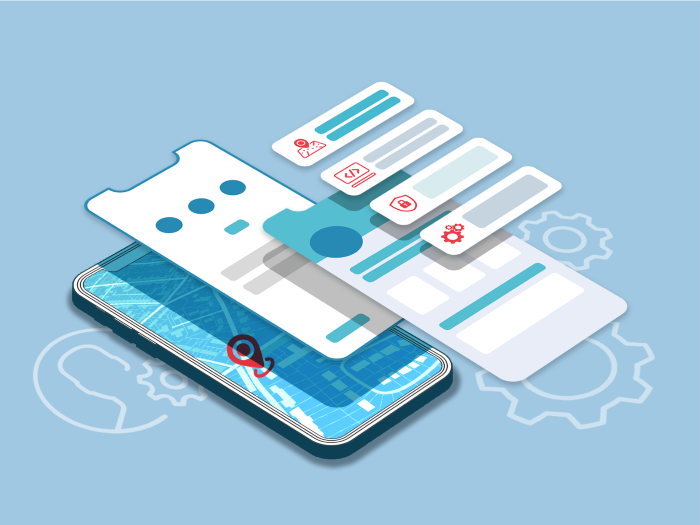 Must-Have Uber App Features: Building a Ridesharing App
Must-Have Uber App Features: Building a Ridesharing App